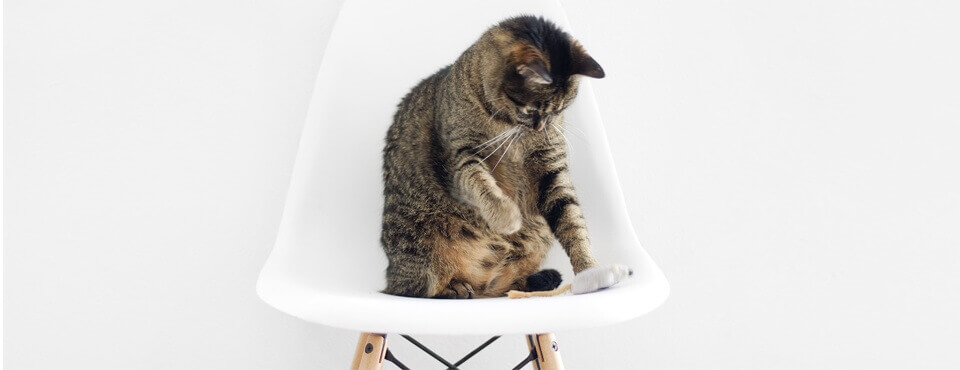Your cat is a valued and loved member of the family, and it is normal to be worried about their wellbeing and be concerned about parasites. Fleas and ticks can be annoying, and even dangerous pests, but with the right plan in place you can protect your cat from these invaders.
A year-round, long-term control plan which acts fast to combat parasites may well be the best choice for you and your cat. It is also important to be aware of the signs of a flea or tick infestation, allowing you to put a stop to the problem as swiftly as possible, and ensuring both your cat and your home are flea and tick free.
FLEAS ON CATS
No type of flea has conquered the world of the cat and the dog quite so much as the cat flea – it is the most abundant of its kind, found across the globe. Fleas can latch on to both animals and humans, hitching a ride and finding their way into your home, and potentially onto your cat. Even indoor cats can be affected, since fleas can travel into your home on other animals, you, your family and visitors, meaning that no cat is completely risk-free.
Fleas are most active in their preferred warm, slightly humid weather, but modern homes and their central heating mean fleas are catered to year-round in most countries. Fleas like to burrow down into the warmth of your cat’s fur, especially in the underside of your cat, where they are both warm and protected.
Fleas are small, streamlined critters, shiny and brown in colour they usually measure up to 3mm in length. They can be spotted by the naked eye but move fast within the fur or jump out the way, making them difficult to spot. Speak to your vet as to how best to prevent fleas in your home!

SIGNS OF FLEAS ON CATS
More often than seeing the fleas themselves, you may see evidence of their feeding activity. This may appear as small dark specks of flea dirt (digested blood) that are easily visible when combings from the coat are placed on damp tissue. In addition, many flea affected cats will suffer from itching which may be mild or severe. Other things to watch out for include:
- Intense scratching and fur biting particularly towards the rear of the cat and on the belly
- Restlessness
- Small bumps or crusty areas of skin, particularly on the neck or along your cat’s back
- Hair loss (alopecia)
Some cats are allergic or more sensitive to flea bites. Watch for your cat scratching for prolonged periods, and if it keeps up the repeated extensive grooming and scratching over several days, it could be caused by flea bites
CHECKING FOR FLEAS
If you believe that your cat has fleas, confirm your suspicions are right. Look in the areas where fleas are more likely to appear – the skin at the base of your cat’s tail, underneath the legs, and in the soft, warm belly fur.
One handy tool for cat owners is a flea comb as it can help you to identify and remove fleas safely from your cat. Not only can it pick up fleas but also flea dirt, which is another indicator that your cat has fleas.
When checking your cat, if you see small dark insects running through its fur, it is time to treat for fleas, and make sure your home is flea-free, too.
TREATING YOUR CAT FOR FLEAS
If you suspect that your cat has fleas, or have found fleas on your pet, pay a visit to your vet. Your vet can advise you on the best treatment plan and how to get rid of fleas in your home. Effective and fast control solutions are available, providing your pet with long-term treatment and protection.
Consult your vet and follow theIR advice to make sure your kitty is flea-free as quickly as possible.

TREATING YOUR HOME FOR FLEAS
Fleas can survive in your home without a host animal for months, so if you know your cat has fleas, it is best to regularly clean bedding, and thoroughly vacuum your floors, to minimise the chances of fleas sticking around in your home.
Throw the dust bag in your vacuum cleaner away each time you use it.
However, don’t wait for your cat to show signs of fleas before you take action. The best kind of treatment when it comes to fleas and other parasites is a solid prevention plan.
The best kind of treatment when it comes to fleas and other parasites is a solid prevention plan.
TICKS ON CATS
Ticks are common in wooded areas, but they can also be found in gardens and hitch a ride into your home on your cat’s fur. They climb onto your cat’s coat as it brushes past vegetation outdoors, and they can also be brought into your home on clothing or by other animals, such as dogs.
Ticks should be dealt with swiftly and effectively, because they can transmit dangerous diseases. Cats can become sick from tick-transmitted diseases. These diseases can be fatal for cats, so it is vital that you provide your cat with an effective tick control plan, helping protect them from tick-borne diseases.
SPOTTING TICKS ON YOUR CAT
Ticks, in general, are big enough to easily spot on cats. Ticks look rather like small spiders, with an oval-shaped body, which grows in size as the tick feeds on blood.
When your cat comes in for dinner, run your hands over its coat and over its body to check for any lumps and bumps. Ticks may feel like small bumps on your cat’s skin. You can also check for ticks by regularly grooming your cat. If you do find a tick, you can remove it at home, but if you don’t feel confident, take your cat to the vet for the tick to be removed.
REMOVING TICKS FROM YOUR CAT
To remove a tick, you will need tweezers or a tick removal tool, and latex or rubber gloves.
Try and get someone to help you hold your cat if necessary, as cats can be wrigglers and difficult to hold still. This, combined with the fact that ticks can be quite tricky to find in the mass of your cat’s fur, mean it is often easier to take your cat to the vet for the tick to be removed.
However, if you do manage to locate the tick and are confident that you can remove it at home, put on your gloves for your own protection and to keep your hands clean. Find where the tick is clinging on to your cat, and grab the tick as close to your cat’s skin as possible, without nipping your cat. In order to remove the tick, slowly but firmly pull the tick straight up and out of the skin.
Place the tick in a jar or a solution containing alcohol. Gently clean your cat’s skin in the area of the bite with a cotton ball or swab.
Keep a close eye on the area where you removed the tick from, and if it still looks red and irritated a few days after removal, take your cat to the vet to check the area.
If you are unsure of what to do or don’t feel confident in tick removal, then take your cat to the vet so they can safely deal with your cat’s tick problem.

CONTROLLING FLEAS AND TICKS IN CATS
Ask your vet about the benefits of each treatment, and whether the treatment provides long-lasting coverage for your pet. For example, if you prefer to use a spot-on treatment, check that it is still effective if your cat gets wet. Ask whether the product is long-lasting, so you don’t have to keep applying it every few days.
Using a product which is effective and long-lasting is the most convenient option, providing your cat with the constant protection they need, and ensuring that your home is a parasite-free zone.
Your vet plays a big role in your pet’s health. Enter your location and get a list of vets near you.
FIND A VET















 Go To United States
Go To United States Austria
Austria Belgium
Belgium Czech Republic
Czech Republic Denmark
Denmark Europe
Europe Finland
Finland France
France Germany
Germany Greece
Greece Hungary
Hungary Ireland
Ireland Israel
Israel Italy
Italy Netherlands
Netherlands Norway
Norway Poland
Poland Portugal
Portugal Romania
Romania Slovakia
Slovakia Spain
Spain Sweden
Sweden Turkey
Turkey United Kingdom
United Kingdom